
Traveling Exhibits
To learn more or to schedule an traveling exhibit, please contact ohcexhibits@history.ok.gov.
African American History
All-Black Towns of Oklahoma
Early Oklahoma: Black Hope/Black Dreams
Thirteen All-Black Towns of Oklahoma
American Indian History
Cherokee Nation: A Portrait of a People
Family Album: Photographs by Pierre Tartoue
Of Influence: Portraits of Cherokee People
Animals
“Where They Went”: A Photographic History of Oklahoma Animals
The Dust Bowl and the Great Depression
Dust, Drought, and Dreams Gone Dry
Photographing the Plains: Farm Security Administration, 1935–1945
Historic Preservation
Fundamentals for Preservation of Oklahoma’s Archeological and Historic Properties
Journalism
50 Years of Photojournalism at The Oklahoman
Labor
Child Labor in Oklahoma: Photographs by Lewis Hine, 1916–1917
Labor Conquers All
Latino(a) History
Exploring Oklahoma’s Latino(a) History
Musical Theatre
Rodgers & Hammerstein’s Oklahoma! The Origin of Modern Musical Theatre
Outlaws and Lawmen
Wanted: Dead or Alive
Railroads
Smoke Over Oklahoma: The Railroad Photographs of Preston George
Sports
Mickey Mantle: Baseball Hero in Black and White
Oklahoma Sports
Women’s History
Votes for Women: 100 Years of Women’s Suffrage
Women of Oklahoma
Exploring Oklahoma’s Latino(a) History

The presence of the Latino(a) community has been felt in Oklahoma since the early days of Spanish exploration in the New World. Originally, the Spanish laid claim to parts of modern-day Oklahoma after the expeditions of Francisco Vázquez de Coronado in 1541 and Juan de Oñate in 1601. The Spanish claim on Oklahoma, which was passed on to Mexico, would last for more than three hundred years. France later claimed a portion as its own territory after Sieur de La Salle ventured west in 1682. With the Adams-Onís Treaty in 1819, the United States gained control of all lands in present Oklahoma except for the Panhandle, which the Republic of Mexico did not cede until the end of the Mexican-American War in 1848.
In Oklahoma, Spanish explorers briefly mixed with Indigenous tribes in the early days of exploration. Later, some Spanish settlers from Mexico were brought to Oklahoma as captives of various tribes, while other settlers hired tribal members to work on ranches across northern areas of Mexican territory. With the formation of the Great Spanish Road, the earliest recorded trail to the Red River, Oklahoma became commercially linked to Mexico, creating an intermixing of goods, cultures, and peoples.
Much of Oklahoma’s Latino(a) population, historically speaking, is of Mexican ancestry. Through the 1960s, Oklahoma’s Latino(a) communities were composed almost exclusively of immigrants from Mexico, ranging from those who fled during the Mexican Revolution, to families that joined their migrant worker relatives in the state and settled here permanently. Some of the numbers are difficult to track because the US census did not offer a racial category for Latin Americans until the 1980s. Still, studies show an uptick in Latino(a) migration to Oklahoma in the 1950s and 1960s, followed by a significant surge after the 1980s.
This exhibit is presented in both English and Spanish. The exhibit includes the immigration of Latino(a) people from pre-statehood to the present day and touches on education, religion, and culture. There are also oral history links included. Visitors can scan a QR code with their phones to listen to an oral history.
- This exhibit features four double-sided banners that measure 36” x 96” and a pedestal case with artifacts.
- A minimum of 500 square feet is recommended, but the exhibit is best viewed with 750 square feet or more.
- The rental fee is $250 per eight-weeks, with one week before and one week after for shipping, set up, and takedown.
- In-state delivery/pick-up is available for $125 each way, with at least two week’s notice.
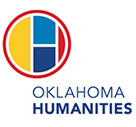
Funding for this program was provided by a grant from Oklahoma Humanities. Any views, findings, conclusions, or recommendations expressed in this exhibit do not necessarily represent those of Oklahoma Humanities.
Wanted: Dead or Alive
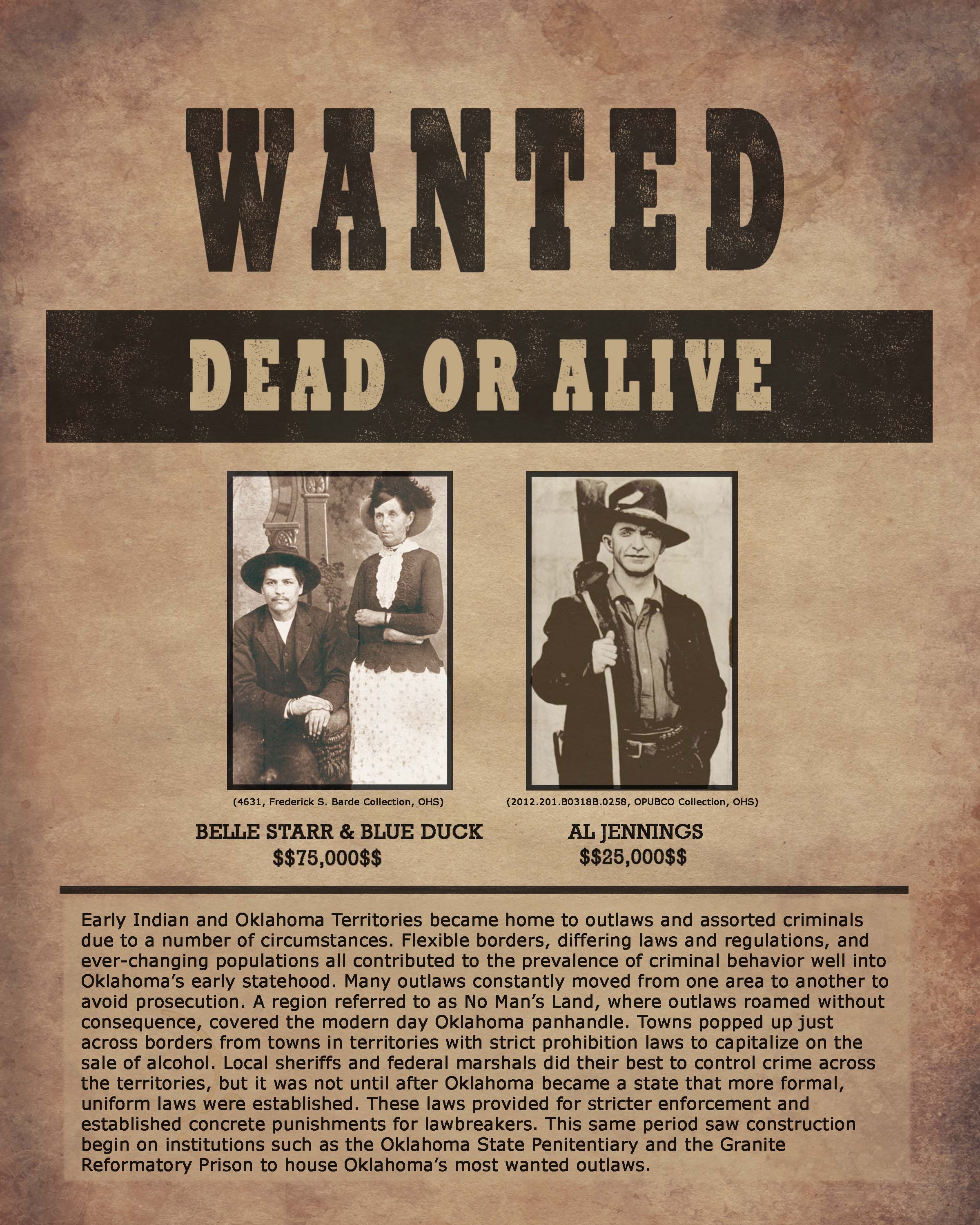
This photography exhibit features images of some of Oklahoma’s most infamous criminals. Images from the Federal Bureau of Investigation, the University of Oklahoma Western History Collections, the National Archives, and the Oklahoma Historical Society include mugshots, crime scene locations and group shots with criminals, and law enforcement officers. They span more than 70 years, starting before statehood in 1907 and reaching into the late 1950s.
While there may be a few familiar names, such as the Doolin and Dalton Gangs and Ma Barker, the exhibit showcases stories that might not be as well known. Visitors will learn about whiskey towns, the Tulsa Central Park Gang, Spencer State Bank, Wanda Bartram, Ralph Roe, and many more. Many of the people featured were born and raised in Oklahoma or moved here and began their lives of crime. Sometimes the stories are as much about the location as the individual. Although many of the tales feature truly despicable characters, others tell of people who temporarily went astray. Some of the accounts include strange twists and turns, and there is even an unsolved mystery.
- This exhibit consists of thirty-nine 11” x 14” framed black-and-white photographs, labels, and an information panel.
- The exhibit travels in two crates that measure 22” high by 20” long by 25” wide, and 16” high by 20” long by 25” wide.
- Our recommended space requirement is a minimum of 150 linear feet.
- Exhibitors may choose to display framed photographs on easels if wall space is not available.
- The rental fee for this exhibit is $250 per eight-week exhibit, with one week before and one week after for shipping, set up, and takedown.
- Shipping fees are not included in the exhibition fee.
- In-state delivery is available for $125 each way with at least two week’s notice.
“Where They Went”: A Photographic History of Oklahoma Animals
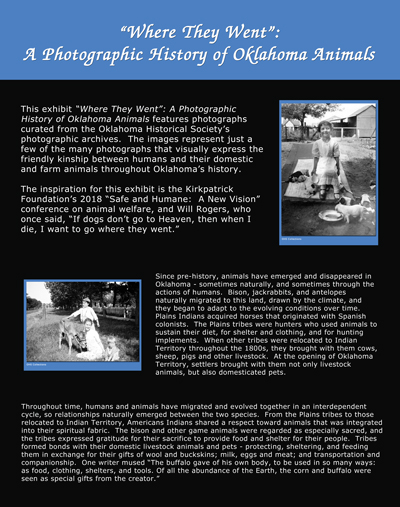
The exhibit “Where They Went”: A Photographic History of Oklahoma Animals features photos curated from the Oklahoma Historical Society’s Photograph Archives. The images in this exhibit represent just a few of our many photographs that express the friendly relationship between humans and their domestic and farm animals throughout Oklahoma’s history.
Funding for this exhibit was provided by the Kirkpatrick Foundation.
Exhibit requirements and fees:
- This exhibit consists of twelve 20” x 30” and fourteen 24” x 30” black-and-white framed photographs, labels, and two information panels.
- The exhibit travels in two crates that measure 37” high by 28” long by 34” wide, and 32” high by 28” long and 34” wide.
- Our recommended space requirement is a minimum of 200 linear feet.
- Exhibitors may choose to display framed photographs on easels if wall space is not available.
- The rental fee is $250 per eight-week exhibit, with one week before and one week after for shipping, set up, and takedown.
- Shipping fees are not included in the exhibition fee.
- In-state delivery is available for $125 each way with at least two week’s notice.
Photographing the Plains: Farm Security Administration, 1935–1945

The Farm Security Administration (FSA) began in 1937 as the successor to the Resettlement Administration (RA), which was formed in 1935 as part of Franklin Delano Roosevelt’s New Deal program. Roy Stryker was hired in 1935 to head the Historical Section, also known as the Information Division. He established a documentary project to provide photographs to public relations outlets including newspapers and magazines.
During the run of the project, from the early days of the RA (1935–36) to the FSA (1937–42) and later as the Office of War Information (1942–45), approximately 175,000 black-and-white negatives and 1,600 color transparencies were produced. These images are now housed at the Library of Congress and are digitized and available to the public.
The photographs in this exhibit are a sample of images by six photographers who visited Oklahoma or photographed displaced Oklahomans looking for work. The photographers are Jack Delano, Dorothea Lange, Russell Lee, Arthur Rothstein, John Vachon, and Marion Post Wolcott.
Exhibit requirements and fees:
- This exhibit consists of twenty framed black-and-white photographs, labels, and an information panel.
- The photographs include one measuring 16” x 20”, eleven at 16” x 16”, and eight at 14” x 20”.
- The exhibit travels in two crates that measure 22” high by 20” long by 25” wide, and 16” high by 20” long by 25” wide.
- Our recommended space requirement is a minimum of 100 linear feet.
- Exhibitors may choose to display framed photographs on easels if wall space is not available.
- The rental fee for this exhibit is $250 per eight-week exhibit, with one week before and one week after for shipping, set up, and takedown.
- Shipping fees are not included in the exhibition fee.
- In-state delivery is available for $125 each way with at least two week’s notice.
Rodgers & Hammerstein’s Oklahoma! The Origin of Modern Musical Theatre
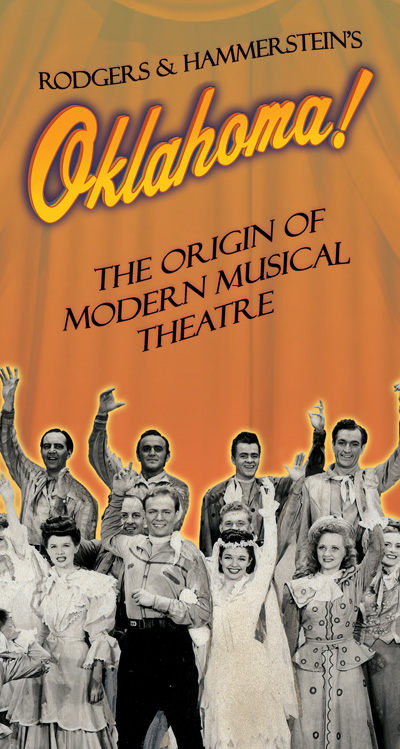
Seventy-five years after Rodgers and Hammerstein adapted Green Grow the Lilacs into Oklahoma!, the duo’s first collaboration remains one of their most celebrated productions. Often considered the first modern musical, Oklahoma! reshaped the Broadway landscape and gave the state of Oklahoma national recognition, pride, and a song that continues to resonate worldwide.
The phenomenon that became Oklahoma! started rather humbly as the 1931 play Green Grow the Lilacs. Green Grow the Lilacs was written by Lynn Riggs, an Oklahoman from just outside of Claremore. The show played a limited engagement of sixty-four performances on the New York stage and embarked on a short, prearranged Theatre Guild tour. In 1943 most of Oklahoma!’s audience was unfamiliar with Riggs’s original work.
When Richard Rodgers and Oscar Hammerstein II signed on to write Oklahoma! in 1942, most of the theatre world considered the project a gamble. Could a “simple” western musical reach a wide audience? How would “cowboy” songs translate to the stage? Initially, the production had trouble finding investors and the Theatre Guild (the New York production company) was quickly running out of time and money. Despite these problems, on March 31, 1943, when Alfred Drake as Curly began to sing “Oh, What a Beautiful Mornin’” from the theatre wings, the audience—and soon, all of Broadway—was hooked.
Rodgers & Hammerstein’s Oklahoma! The Origin of Modern Musical Theatre celebrates the 75th anniversary of the musical (1943–2018). It tells the story of Oklahoma!—from its origin to the 21st century—as it continues to be produced worldwide.
Exhibit requirements and fees:
- The exhibit consists of three retractable banners that measure 33” wide by 80” tall, which are easy to load, unload, and install.
- Venues should allow several hundred square feet of space for the exhibit.
- The rental fee for this exhibit is $125 per eight-week exhibit, with one week before and one week after for shipping, set up, and takedown.
- Shipping fees are not included in the exhibition fee.
- In-state delivery is available for $125 each way with at least two week’s notice.
Women of Oklahoma
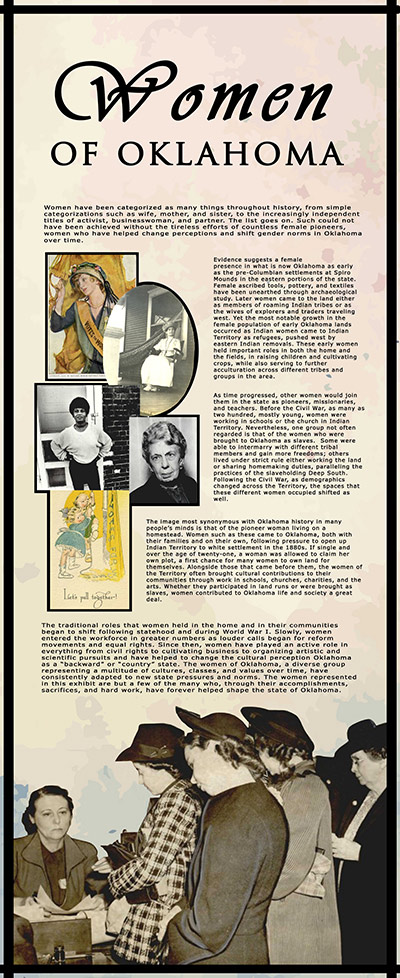
This exhibit highlights women who made history in Oklahoma and across the nation. Visitors will gain a new perspective on how women from Oklahoma have contributed to business, politics, activism, education, and other areas. Included are Hannah Atkins, Clara Luper, Elizabeth Maria Tallchief, and Edith Kinney Gaylord, to name a few.
The female image most synonymous with Oklahoma is the pioneer woman living on a homestead. Women came to Oklahoma, both with their families and on their own, following pressure to open up Indian Territory to white settlement in the 1880s. If single and over the age of twenty-one, a woman was allowed to claim her own plot—a first chance for many women to own land for themselves.
In recent decades, the norms and expectations placed upon women have continued to shift and evolve. The pioneers detailed in this exhibit, through their many accomplishments across diverse fields, classes, and cultures, have set the stage for future contributions. Recently, issues arising for women in the state and across the country include access to certain professional fields, healthcare, and equal opportunities across the board.
Exhibit requirements and fees:
- This exhibit consists of six retractable banners that measure 33” wide by 80” tall, which are easy to load, unload, and install.
- Venues should allow several hundred square feet of space for the exhibit.
- The rental fee for this exhibit is $250 per eight-week exhibit, with one week before and one week after for shipping, set up, and takedown.
- Shipping fees are not included in the exhibition fee.
- In-state delivery is available for $125 each way with at least two week’s notice.
Votes for Women: 100 Years of Women’s Suffrage
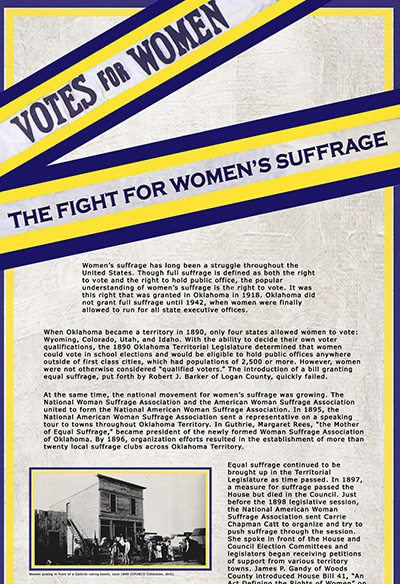
November 5, 2018, marked 100 years of women’s right to vote in Oklahoma. Oklahoma became the twenty-first state to grant suffrage to women by a vote of 106,909 to 81,481. This exhibit explores a history of women since 1890 who were among the first in Oklahoma Territory to lobby for the right to vote. It started with the Woman’s Christian Temperance Union who wanted a voice in school elections. The grassroots efforts grew in 1895 when Laura A. Gregg, a National American Woman Suffrage Association leader, came to Oklahoma to push for a universal right to vote.
Exhibit requirements and fees:
- This exhibit consists of three retractable banners that measure 33” wide by 80” tall, which are easy to load, unload, and install.
- Venues should allow several hundred square feet of space for the exhibit.
- The rental fee for this exhibit is $125 per eight-week exhibit, with one week before and one week after for shipping, set up, and takedown.
- Shipping fees are not included in the exhibition fee.
- In-state delivery is available for $125 each way with at least two week’s notice.
Labor Conquers All
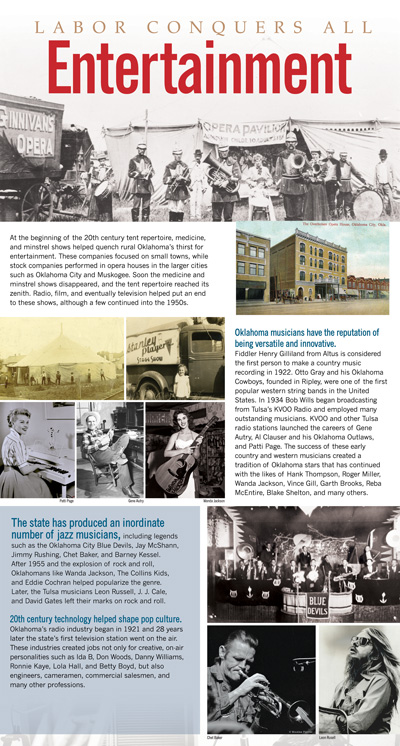
Oklahoma’s state motto is Labor Omnia Vincit, Latin for Labor Conquers All. This exhibit explores the variety of opportunities and resources that contributed to the growth and diversity of the state. Some of the topics include agribusiness, entertainment, public service, retail, and oil. It was sponsored in part by Oklahoma Humanities, the National Endowment for the Humanities, and the Smithsonian Institute.
Exhibit requirements and fees:
- This exhibit includes ten retractable banners, which measure 33” wide by 82” tall.
- It also includes a fabric banner that is 38” wide by 72” tall.
- The exhibit travels in two sturdy cases that measure 16” wide by 45” long by 16” tall and are easy to load and unload.
- Venues should allow several hundred square feet of space for the exhibit.
- The rental fee for this exhibit is $250 per eight-week exhibit, with one week before and one week after for shipping, set up, and takedown.
- Shipping fees are not included in the exhibition fee.
- In-state delivery is available for $125 each way with at least two week’s notice.

Funding for this program was provided by a grant from Oklahoma Humanities. Any views, findings, conclusions, or recommendations expressed in this exhibit do not necessarily represent those of Oklahoma Humanities.
Smoke Over Oklahoma: The Railroad Photographs of Preston George
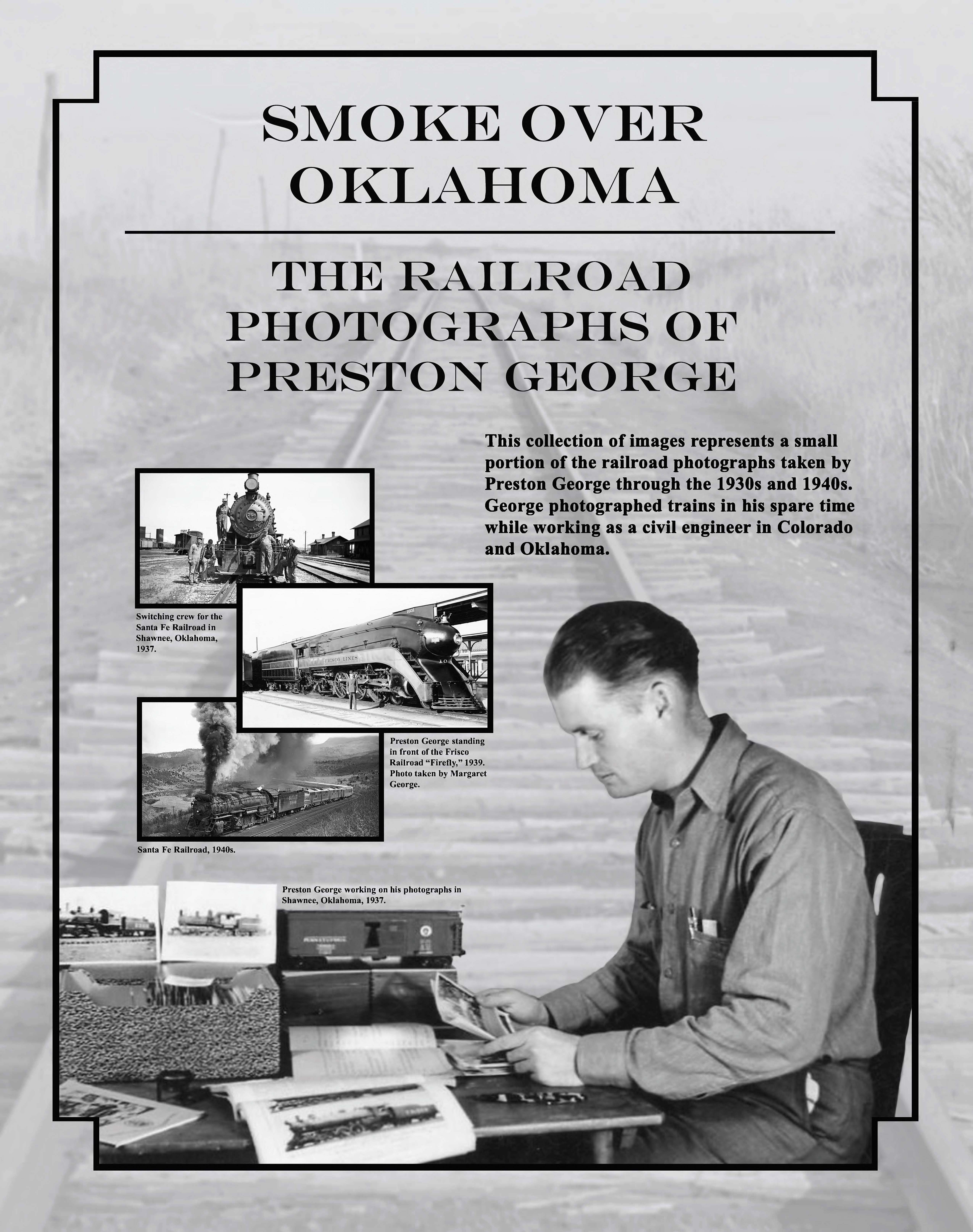
This collection of images represents the railroad photographs taken by Preston George during the 1930s and 1940s. George photographed trains in his spare time while working as a civil engineer in Colorado and Oklahoma. Born in 1906 in Indian Territory, George’s interest in trains began at an early age but did not culminate into a full-fledged pastime until the 1930s when he said, “I ran across a copy of Railroad Stories, later renamed Railroad Magazine, and saw the many photos of locomotives and trains. This started me on a new hobby...Soon, I was snapping still pictures of locomotives with a cheap Kodak camera and trading them far and wide with other fans.”
Exhibit requirements and fees:
- This exhibit consists of twenty-five framed 22” x 30” black-and-white photographs, labels, and an information panel.
- The exhibit travels in two crates that measure 37” high by 28” long by 34” wide, and 32” high by 28” long and 34” wide.
- Our recommended space requirement is a minimum of 200 linear feet.
- Exhibitors may choose to display framed photographs on easels if wall space is not available.
- The rental fee is $250 per eight-week exhibit, with one week before and one week after for shipping, set up, and takedown.
- Shipping fees are not included in the exhibition fee.
- In-state delivery is available for $125 each way with at least two week’s notice.
Child Labor in Oklahoma: Photographs by Lewis Hine, 1916–1917

Social reform photographer Lewis Hine (1874–1940) spent thirty years photographing child labor across the United States. Hired by the National Child Labor Committee, Hine photographed children working in factories, mills, coal mines, farms, and in the streets to bring awareness to the abuse of child labor in early nineteenth-century America. Children were often severely injured or fatally wounded by the unsafe working conditions. Most of the children were kept out of school, and many were illiterate.
Child Labor in Oklahoma: Photographs by Lewis Hine, 1916–1917 is a snapshot of images by Lewis Hine whose photography captured the soul of the child laborer in North America in the early 1900s. Although Hine focused on major cities, he did take brief trips to other parts of the country to document child labor, including Oklahoma. Hine photographed in Tulsa, Oklahoma City, Lawton, Shawnee, Okmulgee, Sulphur, and a few other communities.
Exhibit requirements and fees:
- This exhibit contains twenty-five framed photographs that range in size from 24” x 30” to 20” x 30” and comes with labels and an information panel.
- While supplies last, this exhibit will include an exhibit catalog that is available free to visitors.
- The exhibit travels in two crates that measure 37” high by 28” long by 34” wide, and 32” high by 28” long and 34” wide.
- Our recommended space requirement is a minimum of 200 linear feet.
- Exhibitors may choose to display framed photographs on easels if wall space is not available.
- The rental fee for this exhibit is $250 per eight-week exhibit, with one week before and one week after for shipping, set up, and takedown.
- Shipping fees are not included in the exhibition fee.
- In-state delivery is available for $125 each way with at least two week’s notice.
Funding for this program was provided by a grant from Oklahoma Humanities and the National Endowment for the Humanities. Any views, findings, conclusions, or recommendations expressed in this exhibit do not necessarily represent those of Oklahoma Humanities or the National Endowment for the Humanities.


More about Child Labor in Oklahoma
Child Labor in Oklahoma: Photographs by Lewis Hine, 1916–1917 e-exhibit: view exhibit
Fundamentals for Preservation of Oklahoma’s Archeological and Historic Properties
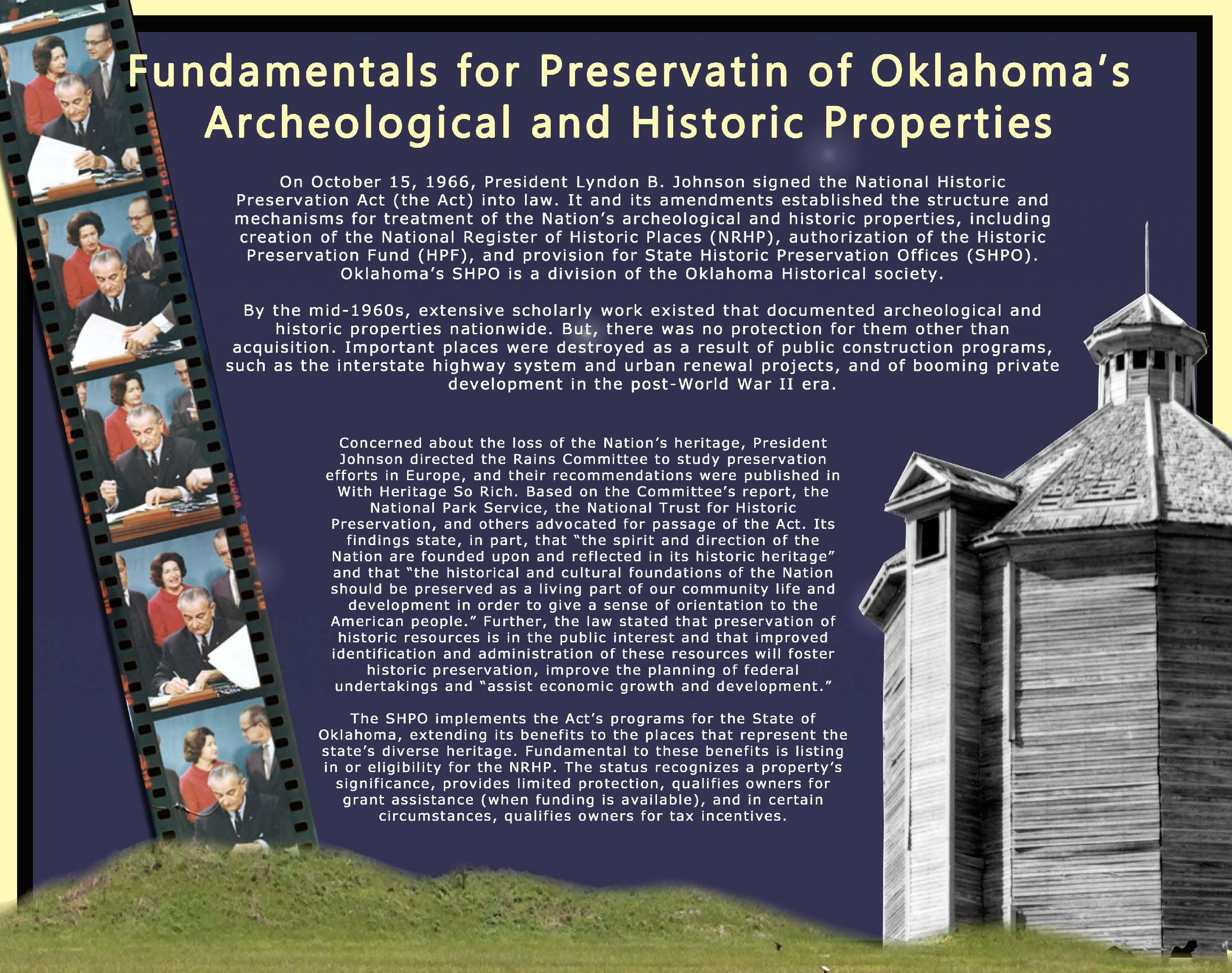
On October 15, 1966, President Lyndon B. Johnson signed the National Historic Preservation Act into law. It and its amendments established the structure and mechanisms for treatment of the nation’s archeological and historic properties, including the creation of the National Register of Historic Places, authorization of the Historic Preservation Fund, and provision for State Historic Preservation Offices (SHPO). Oklahoma’s SHPO is a division of the Oklahoma Historical Society. This exhibit features photographs of twenty-nine of the state’s historic properties and highlights the important work of the State Historic Preservation Office.
Exhibit requirements and fees:
- The twenty-nine framed photographs in this exhibit range in size from 16” x 20” to 11” x 17”.
- Photograph labels and an information panel are also included.
- The exhibit travels in two crates that measure 22” high by 20” long by 25” wide, and 16” high by 20” long by 25” wide.
- Our recommended space requirement is a minimum of 200 linear feet.
- Exhibitors may choose to display framed photographs on easels if wall space is not available.
- The rental fee for this exhibit is $250 per eight-week exhibit, with one week before and one week after for shipping, set up, and takedown.
- Shipping fees are not included in the exhibition fee.
- In-state delivery is available for $125 each way with at least two week’s notice.
Mickey Mantle: Baseball Hero in Black and White

In the 1950s, increased television viewing and media coverage combined with his athleticism helped to propel Mickey Mantle into a superstar, often compared to Babe Ruth. The Oklahoma native known as the “Commerce Comet” exemplified the spirit of a hero through his determination, perseverance, and courage. The Daily Oklahoman extensively covered Mantle throughout his career and life. Oklahomans and baby boomers across the nation were captivated by his talent and sportsmanship. This exhibit explores his life through black and white photographs seen in newsprint and uses the original reporters’ captions to highlight this Baseball Hall of Famer’s milestones.
Exhibit requirements and fees:
- This exhibit contains twenty-five framed photographs that range in size from 24” x 30” to 20” x 30”.
- Photograph labels and an information panel are included.
- The exhibit travels in two crates that measure 37” high by 28” long by 34” wide, and 32” high by 28” long by 34” wide.
- Our recommended space requirement is a minimum of 200 linear feet.
- Exhibitors may choose to display framed photographs on easels if wall space is not available.
- The rental fee for this exhibit is $250 per eight-week exhibit, with one week before and one week after for shipping, set up, and takedown.
- Shipping fees are not included in the exhibition fee.
- In-state delivery is available for $125 each way with at least two week’s notice.
Family Album: Photographs by Pierre Tartoue
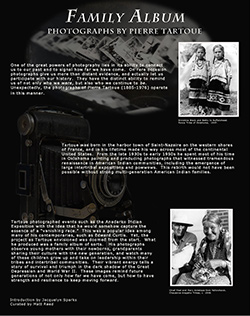
One of the great powers of photography lies in its ability to connect us to our past and to signal how far we have come. On rare occasions photographs give us more than distant evidence and actually let us participate in our history. They have the distinct ability to remind us of not only who we were, but also who we continue to be. The photographs of Pierre Tartoue (1885–1976) operate in this manner.
Tartoue was born in the harbor town of Saint-Nazaire on the western shores of France, and in his lifetime made his way across most of the continental United States. From the late 1930s to early 1950s he spent most of his time in Oklahoma, painting and producing photographs that witnessed a tremendous renaissance in American Indian communities, including the emergence of large intertribal expositions and powwows. This rebirth would not have been possible without strong multi-generation American Indian families. This exhibit was curated by Matt Reed and Jacquelyn Sparks.
Exhibit requirements and fees:
- This exhibit contains twenty-two framed, traditionally printed black-and-white photographs that are matted to 16” x 20”.
- Photograph labels and an information panel are also included.
- The exhibit travels in two crates that measure 22” high by 20” long by 25” wide and 16” high by 20” long by 25” wide.
- Our recommended space requirement is a minimum of 200 linear feet.
- Exhibitors may choose to display framed photographs on easels if wall space is not available.
- The rental fee for this exhibit is $250 per eight-week exhibit, with one week before and one week after for shipping, set up, and takedown.
- Shipping fees are not included in the exhibition fee.
- In-state delivery is available for $125 each way with at least two week’s notice.
More about American Indian history
American Indians in Oklahoma traveling trunk: view trunk description
Dust, Drought, and Dreams Gone Dry
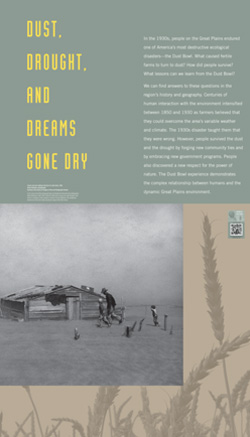
Dust, Drought, and Dreams Gone Dry is a traveling exhibit originally organized by the American Library Association, the National Endowment for the Humanities, and Dr. Jess C. Porter from the University of Arkansas at Little Rock. It traveled to twenty-five sites across the US and is now in the permanent care of the Oklahoma History Center traveling exhibits program.
Part of the exhibit content was drawn from the Oklahoma State University library and features their Women of the Dust Bowl oral histories (visitors will find QR codes throughout the exhibit that link to these oral histories). Mount Holyoke College Library, which houses the Caroline Henderson papers (letters, essays, and articles by a woman who farmed throughout the Dust Bowl) was also an inspiration for the exhibit.
This exhibit will engage visitors as they learn about the human and ecological consequences of one of America’s most disastrous environmental experiences.
Exhibit requirements and fees:
- Each of the ten, double-sided panels measure 38” x 72” and rest in bases, which are provided.
- The exhibit travels in two crates that measure 18” high by 67” long by 41” wide, and 10” high by 79” long by 41” wide.
- Our recommended space requirement is a minimum of 300 square feet.
- The rental fee for this exhibit is $250 per eight-week exhibit, with one week before and one week after for shipping, set up, and takedown.
- Shipping fees are not included in the exhibition fee.
- In-state delivery is available for $125 each way with at least two week’s notice.

Funding for this program was provided by a grant from Oklahoma Humanities. Any views, findings, conclusions, or recommendations expressed in this exhibit do not necessarily represent those of Oklahoma Humanities.
More about the Dust Bowl
Dust Bowl and Great Depression traveling trunk: view trunk description
Teacher resources: Learning About the Great Depression and Dust Bowl through Primary Sources
The Great Depression, the Dust Bowl, and New Deal in Oklahoma e-exhibit: view exhibit
Oklahoma Sports
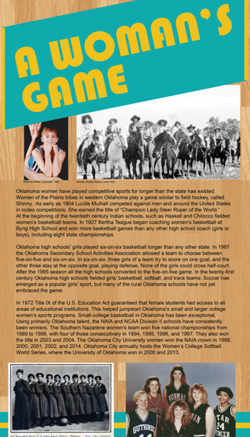
This exciting traveling exhibit provides a window into the history and culture of Oklahoma sports. Many people take pride in the successes of our major colleges and the Oklahoma City Thunder, while some communities live and die with their local high school football and basketball teams. Homegrown athletes who achieved national and international success such as Mickey Mantle, Shannon Miller, Jim Thorpe, and Johnny Bench are treated as Oklahoma royalty. From the warrior tradition of American Indians to the pioneering spirit of men and women who made the land run, Oklahoma’s history is packed with competitors.
Exhibit requirements and fees:
- Each of the twelve retractable banners measure 33” x 86”, and highlight the diversity of sports in Oklahoma with fun information and great photographs.
- The banners travel in two plastic cases and are easy to unload and set up.
- Venues should allow several hundred square feet of space for the exhibit.
- Exhibitors may choose not to display all panels if adequate space is not available, however, it is preferred that all panels be included in the exhibit.
- The rental fee for Oklahoma Sports is $250 per eight-week exhibit, with one week before and one week after for shipping, set up, and takedown.
- Shipping fees are not included in the exhibition fee.
- In-state delivery is available for $125 each way with at least two week’s notice.

Funding for this program was provided by a grant from Oklahoma Humanities. Any views, findings, conclusions, or recommendations expressed in this exhibit do not necessarily represent those of Oklahoma Humanities.
All-Black Towns of Oklahoma
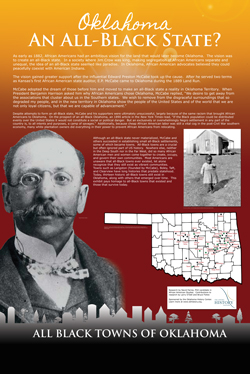
Shortly after the 1889 Land Run opened the Oklahoma Territory to settlement, Black leaders hoped to make the newly-opened lands a home for oppressed African Americans throughout the United States. Oklahoma was promoted as the land where African Americans could come for the dream of "self-government." As many as fifty communities arose where only African Americans lived and governed themselves. Even though "Jim Crow" became the law of the land after statehood, All-Black towns survived and continue to thrive in modern Oklahoma. This exhibit consists of twelve retractable banners with images and text about the unique history of All-Black towns in Oklahoma.
Exhibit requirements and fees:
- The exhibit consists of two large, one-sided retractable banners (introduction and conclusion) that are 60” x 84”, and ten double-sided retractable banners measuring 36” x 84”.
- The exhibit travels in three plastic cases.
- Venues should allow several hundred square feet of space for the exhibit.
- Exhibitors may choose not to display all panels if adequate space is not available, however, it is preferred that all panels be included in the exhibit.
- The rental fee for All-Black Towns of Oklahoma is $250 per eight-week exhibit, with one week before and one week after for shipping, set up, and takedown.
- Shipping fees are not included in the exhibition fee. In-state delivery is available for $125 each way with at least two week’s notice.
More about African American history
African Americans in Oklahoma traveling trunk: view trunk description
The African American Civil Rights Movement in Oklahoma e-exhibit: view exhibit
The Tulsa Race Massacre e-exhibit: view exhibit
We Remember...Before and Beyond: An African American History Coloring Book: view online
Thirteen All-Black Towns of Oklahoma
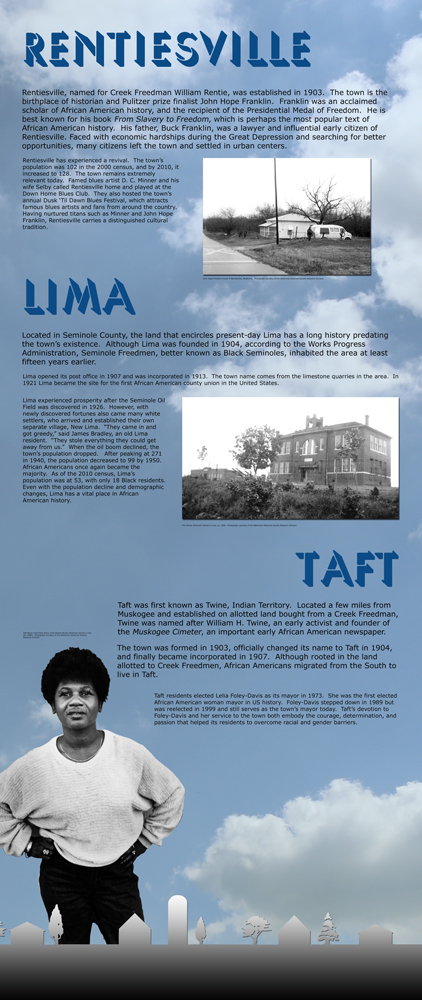
This smaller version of the All-Black Towns of Oklahoma exhibit highlights the thirteen towns that are still incorporated today. E. P. McCabe came to Oklahoma in the 1889 Land Run, he said, "to get away from the associations that cluster about us in the Southern states. We wish to remove from the disgraceful surroundings that so degrade my people, and in the new territory of Oklahoma show the people of the United States and of the world that we are not only loyal citizens, but we are capable of advancement." The vision was to create an All-Black state. Although that never materialized, McCabe and others succeeded in establishing All-Black towns.
Nowhere else, neither in the Deep South nor the Far West, did so many African American men and women come together to create, occupy, and govern their own communities. Boley, Brooksville, Clearview, Grayson, Langston, Lima, Red Bird, Rentiesville, Taft, Tatums, Tullahassee, Summit, and Vernon are the towns highlighted in this exhibit.
Exhibit requirements and fees:
- The exhibit consists of five retractable banners that measure 36” wide by 88” high, are lightweight, and easy to handle and set up.
- Venues should allow several hundred square feet of space for the exhibit.
- Our rental fee is $250 per eight-week exhibit, with one week before and one week after for shipping, set up, and takedown.
- Shipping fees are not included in the exhibition fee.
- In-state delivery is available for $125 each way with at least two week’s notice.
More about African American history
African Americans in Oklahoma traveling trunk: view trunk description
The African American Civil Rights Movement in Oklahoma e-exhibit: view exhibit
We Remember...Before and Beyond: An African American History Coloring Book: view online
Early Oklahoma: Black Hope/Black Dreams
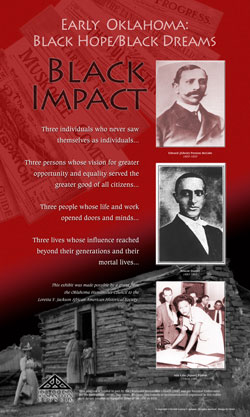
Early Oklahoma: Black Hope/Black Dreams features the accomplishments of three individuals who had a vision for greater opportunity and equality for themselves and others. Their accomplishments opened doors and opened minds; their influence reached beyond their generations and lifespan. Edward (Edwin) Preston McCabe arrived in Oklahoma Territory in 1889. He was experienced in finance, law, land development, and politics. McCabe sought a place where African Americans could establish their own towns similar to other groups of Americans. Roscoe Dunjee was a newspaperman, activist, humanitarian, and a man of extraordinary conviction and legendary accomplishment. He was one of the most influential men in Oklahoma history. As he was only one generation removed from slavery, Dunjee was a general on the battlefield for civil rights. Founded in 1915, Dunjee’s newspaper was titled the Black Dispatch. Dunjee also took aim at the legal system and the issues, incidents, and laws that deprived African Americans of their rights of citizenship and human dignity. Ada Lois Sipuel Fisher was the first African American admitted to the University of Oklahoma Law School on June 18, 1949, and the first to graduate in August 1951. Through her, African Americans succeeded in challenging the separate but equal doctrine as it applied to educational opportunities.
Exhibit requirements and fees:
- This exhibit consists of five free-standing retractable banners with double-sided graphics.
- The minimum space requirement is 22’ x 9’.
- The exhibit travels in one high-impact plastic case with wheels.
- The exhibit fee for Early Oklahoma: Black Hope/Black Dreams is $250 per eight-week exhibit, with one week before and one week after for shipping, set up, and takedown.
- Shipping is not included in the exhibition fee.
- In-state delivery is available for $125 each way with at least two week’s notice.
More about African American history
African Americans in Oklahoma traveling trunk: view trunk description
The African American Civil Rights Movement in Oklahoma e-exhibit: view exhibit
We Remember...Before and Beyond: An African American History Coloring Book: view online

50 Years of Photojournalism at The Oklahoman
Photojournalists have played an important role in the preservation and documentation of Oklahoma history. This exhibit features framed images from the Oklahoma Publishing Company dating from 1950 to 2000. More than twenty photographers, many from Oklahoma, are represented.
Exhibit requirements and fees:
- The exhibit consists of fifty-six framed images. Fifty-one of the images are 8” x 10” framed images and labels, five 16” x 20” images and labels (these five are enlarged duplicates of selected smaller images), one framed title panel, one framed credit panel, and five decade overview scripts.
- The exhibit travels in four crates that weigh up to 75 pounds each. Three are 33” wide by 29” deep by 21” high, and one is 31” wide by 27” deep by 30” high.
- Images are packed in the crates according to an attached list; this order must be maintained.
- Venues should allow for approximately eighty linear running feet for a double-hung exhibition.
- Exhibitors may choose not to include the duplicate, enlarged images; it is preferred that all other images be included in the exhibit.
- The rental fee for 50 Years of Photojournalism at The Oklahoman is $250 per eight-week exhibit, with one week before and one week after for shipping, set up, and takedown.
- In-state delivery is available for $125 each way with at least two week’s notice.
Cherokee Nation: A Portrait of a People

This exhibit presents fifty-five portraits of individuals, couples, and families by noted Oklahoma photographer and artist David Fitzgerald. The strikingly clear and visually rich photographs allow the viewer insight into elements in the broad spectrum of Cherokee life in Oklahoma today. Several of the individuals in these portraits are elders who have been named a Living National Treasure/Master Craftsperson. Whether the photographs depict settings associated with traditional practices or contemporary occupations, Fitzgerald’s images convey his respect and affinity for the people in this project.
The Cherokees, the Ani Yun Wiya, or “real people,” have made Oklahoma their home for nearly two centuries. But many still remember another homeland in the southern Appalachian Mountains as their ancestral home before they were forced west of the Mississippi River. Distantly related to the Six Nations of the Iroquois in the Northeast, Cherokee people believed that “The Great Spirit who is the father of the human family and to whom the whole earth belongs” gave them the hunting grounds and the river valleys of Kentucky, Tennessee, Virginia, the Carolinas, and Georgia. David Fitzgerald’s remarkable photography provides a glimpse of a contemporary people tied, each in their own way, to a rich cultural past.
I still live in the old ways and the belief of my ancestors, forefathers, and elders. I still believe in the sacred religious ceremonial grounds of long ago, which they say is long ago, but we still serve the same creator as our ancestors did. We still sing the same songs they sang long ago, but they are the very same songs as yesterday, tomorrow and forever. With these songs, the creator gives us strength to go on day after day till he returns. Once again we will be as one. Take these words to your heart, to your home, wherever you go. If we don’t meet here, with our prayers and guidance, we will meet at the creator’s table, for there is no such thing as “goodbye” in the Cherokee language, just see you later.
—Boss Cummings, Cherokee, US Army Vietnam Veteran and Elder of the ROC Ceremonial Ground, 2001
Like many people before me, I have found myself lost in the incredible history of the Cherokee people. Within these portraits lies the strength of a proud people regaining their national sovereignty that was tragically stripped from them in the 1800s, and then sadly repeated in the years that followed. The warmth and friendships shared with me over the past three years have become an experience I will cherish the rest of my life.
—David Fitzgerald, 2001
Exhibit requirements and fees:
- The exhibit consists of fifty-seven framed images.
- Eleven of the images are 32” x 37.5” (includes one framed title panel and one artist biographical and image technical panel) and forty-six images are 22.75” x 26.5”.
- There are nine framed interpretative panels which measure 30.25” x 36.25”.
- The exhibit travels in six crates with images packed according to an attached list; this order must be maintained.
- The venue should allow for approximately 220 linear feet for single-hung exhibition with interpretative panels.
- Exhibitors may choose other options of hanging the exhibit; however, it is preferred that all images and panels be included in the exhibition.
- The rental fee for Cherokee Nation: A Portrait of a People is $1,000 per eight-week exhibit, with one week before and one week after for shipping, set up, and takedown.
- Shipping fees are not included in the exhibition fee.
- In-state delivery is available for $125 each way with at least two week’s notice.
More about American Indian history
American Indians in Oklahoma traveling trunk: view trunk description
Of Influence: Portraits of Cherokee People
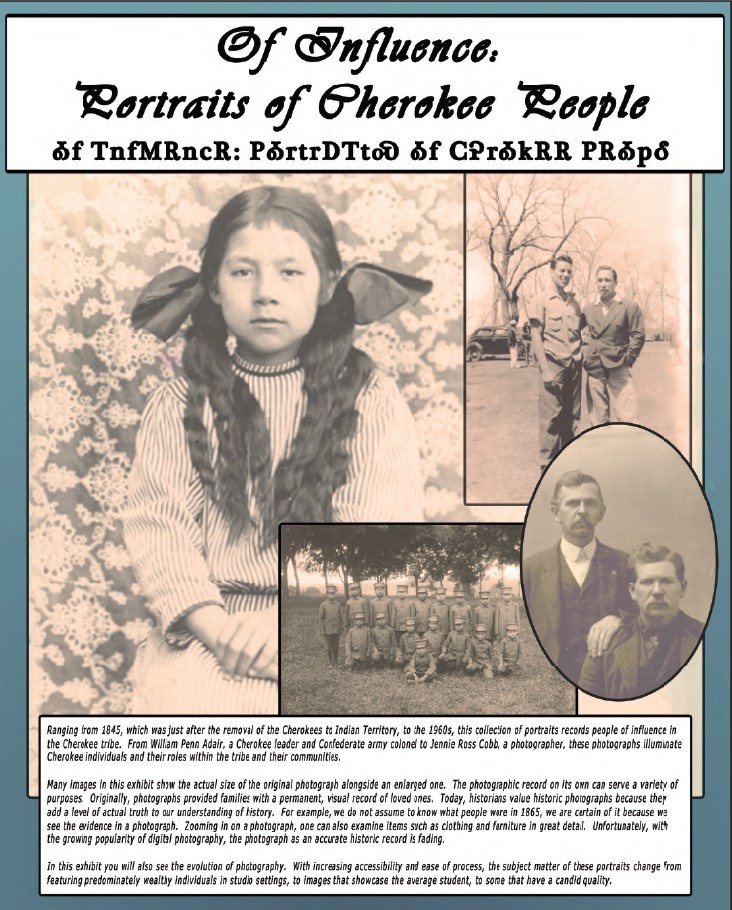 Ranging from 1845 to the 1960s, this portrait collection presents people of influence in the Cherokee tribe. From Cherokee leader and Confederate Colonel William Penn Adair to photographer Jennie Ross Cobb, these photographs illuminate Cherokee individuals and their roles within their tribe and communities. Many images in this exhibit show the actual size of the original photograph alongside an enlarged version.
Ranging from 1845 to the 1960s, this portrait collection presents people of influence in the Cherokee tribe. From Cherokee leader and Confederate Colonel William Penn Adair to photographer Jennie Ross Cobb, these photographs illuminate Cherokee individuals and their roles within their tribe and communities. Many images in this exhibit show the actual size of the original photograph alongside an enlarged version.
Exhibit requirements and fees:
- The exhibit consists of twenty-two photographs that measure 20” x 24” and two that measure 24” x 30”.
- Photograph labels and an information panel are included.
- The exhibit travels in two crates that measure 37” high by 28” long by 34” wide, and 32” high by 28” long and 34” wide.
- Our recommended space requirement is a minimum of 200 linear feet.
- Exhibitors may choose to display framed photographs on easels if wall space is not available.
- The rental fee is $250 per eight-week exhibit, with one week before and one week after for shipping, set up, and takedown.
- Shipping fees are not included in the exhibition fee.
- In-state delivery is available for $125 each way with at least two week’s notice.
More about American Indian history
American Indians in Oklahoma traveling trunk: view trunk description

